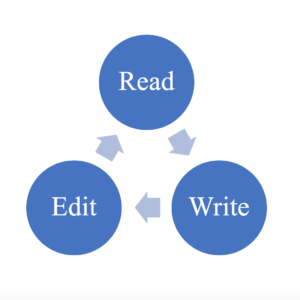Last spring, my JP adviser passed on a piece of wisdom from his graduate adviser: for a research project, you should spend one third of your time reading, one third of your time writing, and one third of your time editing.
This was new to me. Historically, I’d spent 80% of my time reading, 19% of my time writing, and 1% (at best) of my time editing. I had always told myself that it didn’t make sense to start writing until I’d read everything and figured out what I wanted to say. Also, reading almost always felt easier and safer than writing. Instead of constructing my own ideas, I could sit back and receive other people’s finished products.

The problem was: I never ran out of things to read. Most of the time, I would only start writing once the deadline was in sight and I had no more time to waste. Rarely would I have enough time to edit my work.
For my thesis, though, I’m trying to follow my JP adviser’s system, spending equal amounts of time reading, writing, and editing. It took me until this week to realize that I need to treat these three elements as parts of a cycle, rather than macro chronological steps. In other words, I realized that I shouldn’t spend the first half of my fall semester just reading, the next few months writing, and the next few months editing. I need to be doing all three simultaneously. My reading, writing, and editing should be working in tandem with each other.
While doing thesis research over the summer, I was afraid to start writing too soon. I was still figuring out the parameters of my topic, and I was also afraid I would just regurgitate the ideas I was reading. So I’ve written pages and pages of notes, but have made very little progress on my actual argument (I only just started writing my own thoughts, after four months of reading).
When my adviser recently asked for five pages of writing, I was confronted with how little progress I’d made. As I started to write, I found myself returning to sources I’d already read and annotated, but had never synthesized in the context of my project. Clearly, I had missed a step.
To fix this, I’ve started putting the information I read directly into my draft—even if it belongs in a chapter I haven’t started yet. I just write a section header and one or two sentences—or, if I’m feeling lazy, a few phrases, so the information is set up for easy integration during editing. Doing this also helps me visualize where I still need to gather more data. For example, I recently discovered that I have way too much material for my background section, and still almost nothing for my third chapter. I’m glad I’m discovering this now, and not when it’s too late to reorganize my reading plan.
Reading while writing is a totally different experience than reading with no immediate objective or output. Trying to predict what information will be useful later on is much less efficient than just synthesizing the information immediately, and returning with edits as the section expands. Writing and editing are part of the research process, not just its end products.
Even though I’m only starting this practice senior year, it applies equally well to smaller writing projects. When I’m on a time crunch for shorter research papers, it’s helpful to begin writing immediately—even if I still haven’t fully processed my argument or evidence. Writing can clarify what I need to read next, and can also help transform a dauntingly empty Word document into a solid early draft with minimal extra effort.
–Rafi Lehmann, Humanities Correspondent

